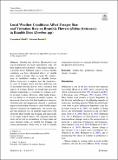Files in this item
Local weather conditions affect forager size and visitation rate on bramble flowers (Rubus fruticosus) in bumble bees (Bombus spp)
Item metadata
| dc.contributor.author | Uthoff, Cassandra | |
| dc.contributor.author | Ruxton, Graeme | |
| dc.date.accessioned | 2022-05-12T15:30:25Z | |
| dc.date.available | 2022-05-12T15:30:25Z | |
| dc.date.issued | 2022-05-01 | |
| dc.identifier | 279530445 | |
| dc.identifier | d191d2fc-f1fe-447b-a176-dac8bf218528 | |
| dc.identifier | 85128926044 | |
| dc.identifier | 000788443800001 | |
| dc.identifier.citation | Uthoff , C & Ruxton , G 2022 , ' Local weather conditions affect forager size and visitation rate on bramble flowers ( Rubus fruticosus ) in bumble bees ( Bombus spp ) ' , Journal of Insect Behavior , vol. 35 , pp. 17-30 . https://doi.org/10.1007/s10905-022-09797-1 | en |
| dc.identifier.issn | 1572-8889 | |
| dc.identifier.other | RIS: urn:3C005B2058AEB3A9ACCD446B08949BAA | |
| dc.identifier.other | RIS: Uthoff2022 | |
| dc.identifier.other | ORCID: /0000-0001-8943-6609/work/113061003 | |
| dc.identifier.uri | https://hdl.handle.net/10023/25358 | |
| dc.description | Funding: Open Access funding enabled and organized by Projekt DEAL. This research was funded by the University of St Andrews, Scotland. | en |
| dc.description.abstract | Bumble bees (Bombus; Hymenoptera) are crucial pollinators for many agricultural crops, but their numbers have declined - with climate change as a possible driver. Different aspects of local weather conditions can have substantial effects on bumble bees’ ability to forage. Here we made 501 observations of bumblebee workers on bramble flowers (Rubus fruticosus) to explore how the characteristic sizes of foragers active and their individual rate of movement between flowers were correlated with aspects of weather. Firstly, we found that increased ambient temperature is correlated to reduced activity in larger workers. Moreover, while higher humidity was linked to an increase in smaller workers, an increase in cloud cover led their numbers to decrease. Visitation rate and temperature showed a significant negative relationship whereas no other weather aspect affected visitation rate significantly. Our results suggest that predicted rises in ambient temperatures will adversely affect bumble bee foraging, and particularly so for larger-bodied workers. We anticipate that this study can be used as a foundation for longer-term and more detailed studies on bumble bee foraging and colony performance. Such work is vital to identify management measures to mitigate pollinator declines and preserve food security. | |
| dc.format.extent | 14 | |
| dc.format.extent | 1325479 | |
| dc.language.iso | eng | |
| dc.relation.ispartof | Journal of Insect Behavior | en |
| dc.subject | Bumble bees | en |
| dc.subject | Pollinators | en |
| dc.subject | Climate change | en |
| dc.subject | Foraging | en |
| dc.subject | QK Botany | en |
| dc.subject | NDAS | en |
| dc.subject | SDG 2 - Zero Hunger | en |
| dc.subject | SDG 13 - Climate Action | en |
| dc.subject | MCC | en |
| dc.subject.lcc | QK | en |
| dc.title | Local weather conditions affect forager size and visitation rate on bramble flowers (Rubus fruticosus) in bumble bees (Bombus spp) | en |
| dc.type | Journal article | en |
| dc.contributor.institution | University of St Andrews. School of Biology | en |
| dc.contributor.institution | University of St Andrews. Centre for Biological Diversity | en |
| dc.contributor.institution | University of St Andrews. Institute of Behavioural and Neural Sciences | en |
| dc.identifier.doi | 10.1007/s10905-022-09797-1 | |
| dc.description.status | Peer reviewed | en |
This item appears in the following Collection(s)
Items in the St Andrews Research Repository are protected by copyright, with all rights reserved, unless otherwise indicated.

